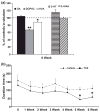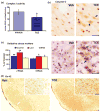Trichloroethylene induces dopaminergic neurodegeneration in Fisher 344 rats
- PMID: 19922440
- PMCID: PMC3535262
- DOI: 10.1111/j.1471-4159.2009.06497.x
Trichloroethylene induces dopaminergic neurodegeneration in Fisher 344 rats
Abstract
Trichloroethylene, a chlorinated solvent widely used as a degreasing agent, is a common environmental contaminant. Emerging evidence suggests that chronic exposure to trichloroethylene may contribute to the development of Parkinson's disease. The purpose of this study was to determine if selective loss of nigrostriatal dopaminergic neurons could be reproduced by systemic exposure of adult Fisher 344 rats to trichloroethylene. In our experiments, oral administration of trichloroethylene induced a significant loss of dopaminergic neurons in the substantia nigra pars compacta in a dose-dependent manner, whereas the number of both cholinergic and GABAergic neurons were not decreased in the striatum. There was a robust decline in striatal levels of 3, 4-dihydroxyphenylacetic acid without a significant depletion of striatal dopamine. Rats treated with trichloroethylene showed defects in rotarod behavior test. We also found a significantly reduced mitochondrial complex I activity with elevated oxidative stress markers and activated microglia in the nigral area. In addition, we observed intracellular alpha-synuclein accumulation in the dorsal motor nucleus of the vagus nerve, with some in nigral neurons, but little in neurons of cerebral cortex. Overall, our animal model exhibits some important features of Parkinsonism, and further supports that trichloroethylene may be an environmental risk factors for Parkinson's disease.
Figures





References
-
- Akundi RS, Macho A, Munoz E, Lieb K, Bringmann G, Clement HW, Hull M, Fiebich BL. 1-Trichloromethyl-1,2,3,4-tetrahydro-beta-carboline-induced apoptosis in the human neuroblastoma cell line SK-N-SH. J Neurochem. 2004;91:263–273. - PubMed
-
- Andersen JK. Oxidative stress in neurodegeneration: cause or consequence? Nat Med. 2004;10(Suppl):S18–S25. - PubMed
-
- Braak H, Del Tredici K, Rub U, de Vos RA, Jansen Steur EN, Braak E. Staging of brain pathology related to sporadic Parkinson’s disease. Neurobiol Aging. 2003;24:197–211. - PubMed
-
- Bringmann G, Hille A. Endogenous alkaloids in man, VII: 1-trichloromethyl-1,2,3,4-tetrahydro-beta-carboline – a potential chloral-derived indol alkaloid in man. Arch Pharm. 1990;323:567–569. - PubMed
-
- Bringmann G, God R, Feineis D, Janetzky B, Reichmann H. TaClo as a neurotoxic lead: improved synthesis, stereo-chemical analysis, and inhibition of the mitochondrial respiratory chain. J Neural Transm. 1995a;46:245–254. - PubMed
Publication types
MeSH terms
Substances
Grants and funding
LinkOut - more resources
Full Text Sources
Medical
Miscellaneous

